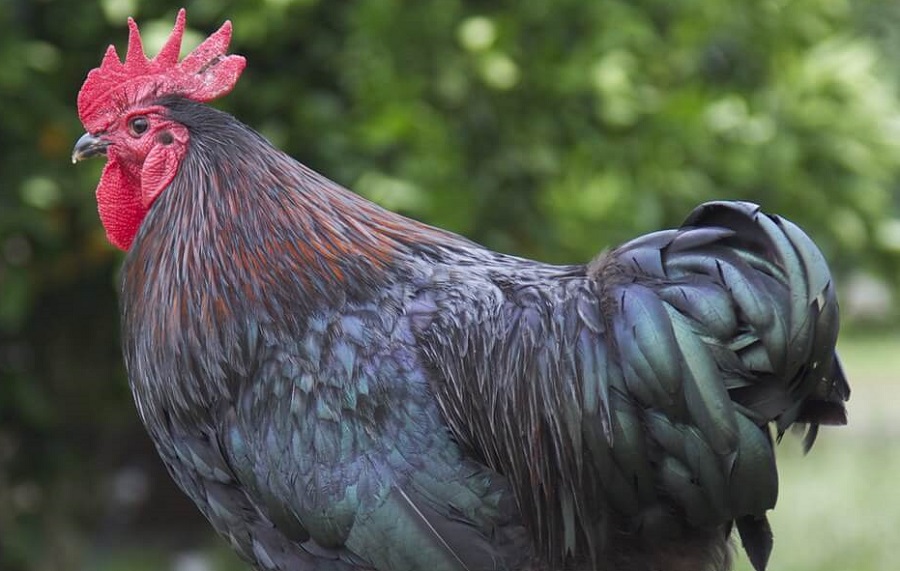Before the modern era of frozen chicken and egg farms, dual-purpose chickens were found in nearly every backyard. These breeds of chickens are quick to gain weight, have good flavor, and lay a great number of eggs a year.
What are dual-purpose chicken breeds? Dual-purpose chickens are chicken breeds whose hens lay a lot of eggs each year and whose roosters have a good size of weight. This makes them great for meat chickens, while also providing eggs for your family. Dual-purpose chicken breeds are a sustainable way to raise chickens.
These top dual-purpose chicken breeds don’t have quite as good of feed-weight conversion as these top meat chicken breeds. You can also check out our article on chicken breeds are extraordinarily high egg layers, or which ones lay colored eggs.
What Are The Best Dual Purpose Chicken Breeds? The top 15 dual-purpose chicken breeds are based on a combination of eggs per year and weight. Heavier chickens are preferred for meat, but higher egg layers are preferred for eggs.
17 Chickens Great For Meat and Eggs
| Dual Purpose Great Egg Layer Very Hardy |
||||
| Very Adaptable Dual Purpose High quality meat |
||||
| Dual purpose Not as popular in USA for meat Hybrid chickens |
||||
| Dual Purpose Great for beginners Very Friendly |
||||
| High egg layer Content bird Easy to raise |
||||
| Heritage Chicken Dual Purpose Kid-Friendly Roosters |
||||
| Very heat and cold tolerant Dual purpose Great for backyards |
||||
| Self-sufficient Birds Loved as a meat bird Family Friendly |
||||
| Whiter Meat Very Heat Hardy Rare Chicken |
||||
| Great dual purpose Cold Hardy Dual Purpose |
||||
| Slow growth Very large Dual Purpose |
||||
| Great in artic cold Dual purpose chicken Calm Chicken |
||||
| 150-180 | Loved as a delicacy More fragile Good for backyards |
|||
| Slow growth Very friendly 2nd Largest Chicken |
||||
| Rare birds Dual Purpose Very happy birds |
||||
| Cross of New Hampshire and Plymouth Rock Dual Purpose |
||||
| Slow growth Friendly Dual Purpose |
When choosing the best dual-purpose chicken for you, take into account your climate and available space. Access the predator risk and decide whether or not you will want a mellow, tame chicken that will also function as a family pet.
This article will include an easy to read chart that tells which breeds are ideal for backyards, free-ranging, and family pets, in addition to being great dual-purpose birds!
1. Australorp Chickens: The Best Dual Purpose Chicken And Egg Laying Machines
Australorps lay an incredible amount of eggs. They made our Chickens That Lay 300 eggs a year list. But, they are also an awesome meat bird as well.
Roosters can get between 8-10 lbs, which makes them a great size. They handle confinement pretty well and have lovely florescent black feathering.
For more information on Australorp chickens, including best care practices and other considerations, click here.

Photo credit: An Porteus Flickr
| Climate | Personality | Use | Size | Eggs/ Yr | Brooder | Forages |
| Hot & Cold | Shy, Calm | Eggs &
Meat |
M: 8.5 lbs
F: 6. lbs |
250-300 | Average | Yes |
- Dual Purpose 300+ eggs 10 lbs
- Shy & Calm
- Cold & Heat Hardy
2. Rhode Island Red Chickens: Vibrant-Red Dual Purpose Chicken
Rhode Island Reds are one of the most successful chicken breeds in the world. They are super popular.
In 1854, a sea captain, William Tripp, bred a Malay chicken with his own chickens. He noticed that the offspring produced more eggs. He enlisted the help of his friend, John Macomber, and breeding began in earnest.
Eventually, Isaac Wilbour bought some birds from the new breed and continued to refine it. As a result, Wilbour usually gets the credit of the Rhode Island Red.
They were bred as a dual purpose bird. They are the official bird of Rhode Island and have two statues in the state erected to the breed.
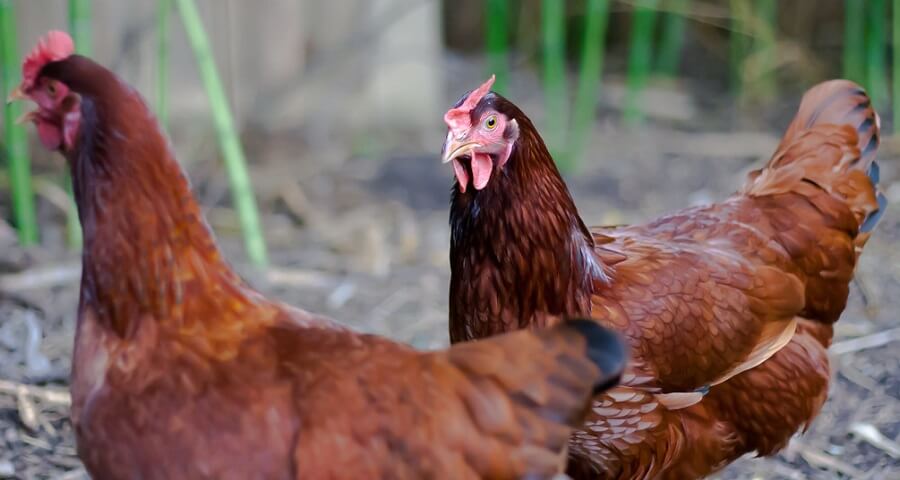
Photo Credit; Red Garrett Heath Flickr
Rhode Island Red’s Physical Traits
The body of a Rhode Island Red Chicken looks like a long brick. The birds are red, although it can vary from a brilliant red to a dark vibrant red. They can have a little black on their tail feathering.
They have hard feathers with red wattles, comb and ear lobes. Their feet and legs are yellow with some darker coloring down the shanks.
Rhode Island Red chickens, single comb, were admitted to the American Poultry Association in 1904. Rose comb was accepted in 1905. Since that time, the color of their red feathers has changed.
They are considered a heritage chicken. Rhode Island Reds usually live 4-8 years with an average lifespan of 6 years.. The older breed may have a longer lifespan depending on genetics.
Reasons To Raise Rhode Island Red Chickens
Rhode Island Red chickens were first bred as a dual purpose bird. Since the breed was created, there has been a split of the breed between a heritage version and a newer commercial breed. The heritage RI Reds have a good table quality and are also used for show birds. The commercial variety isn’t often used for meat, although it may be a good meat bird still. Instead, they are usually used for their superior egg-laying abilities.
Rooster grow to 8.5 lbs (3.85 kgs) and hens grow to 6.5 lbs (2.9 kgs).
They lay a good number of eggs too! There are two varieties of Rhode Island Red, the commercial variety and the heritage breed.
The Rhode Island Red commercial variety usually lays about 5-6 times a week, even during the cold season. That means between 200-300 eggs a year.
The heritage breed will lay between 150-250 eggs a year. The eggs are a large, brown egg. The size of the eggs will get bigger as the hen grows older.
The hens are rarely broody, but when they do, they are good mothers.
Caring For Your Rhode Island Red Chickens
Rhode Island Red chickens may be the easiest chickens to care for. Their laid-back and adaptable in almost any situation.
Plus, they are active foragers. They also do well in confinement. They are super adaptable and will thrive in any climate. They do well in very cold climates and very hot climates.
They are a very laid back bird that doesn’t stress out. They tolerate challenges very well. They can handle adversity and adjust to a wider variety of food and situations.
Rhode Island Reds are a great bird for first-time chicken owners because they are assertive, but won’t be obnoxious. They also won’t struggle with many of the mistakes a first-time poultry raiser can make.
They are friendly and can be tamed.
The heritage breed is on watch status, but the modern version is common.
| Climate | Personality | Use | Size | Eggs/ Yr | Brooder | Forages |
| Any Climate | Adaptable Friendly | Eggs & Meat | M: 8.5 lbs
F: 6.5 lbs |
200 | No | Yes |
- Great Egg Layer
- Super adaptable in any situation
- Very laid back and friendly
3. Black Star Chickens: Strong Egg Layer and Lots of Meat
The Black Star Chicken breed is a hybrid. It also made our chickens that lay 300 eggs a year list. They will lay between 250-300 eggs a year and roosters can grow to 8 lbs.
Black Star roosters are easily identifiable with a black feathering and a white dot on their heads. Hens have no black spot but have golden feathers on their breasts.
They are easy, friendly chickens that do well in many climates. For more information about the specific strengths of Black Star chickens, check out this article.
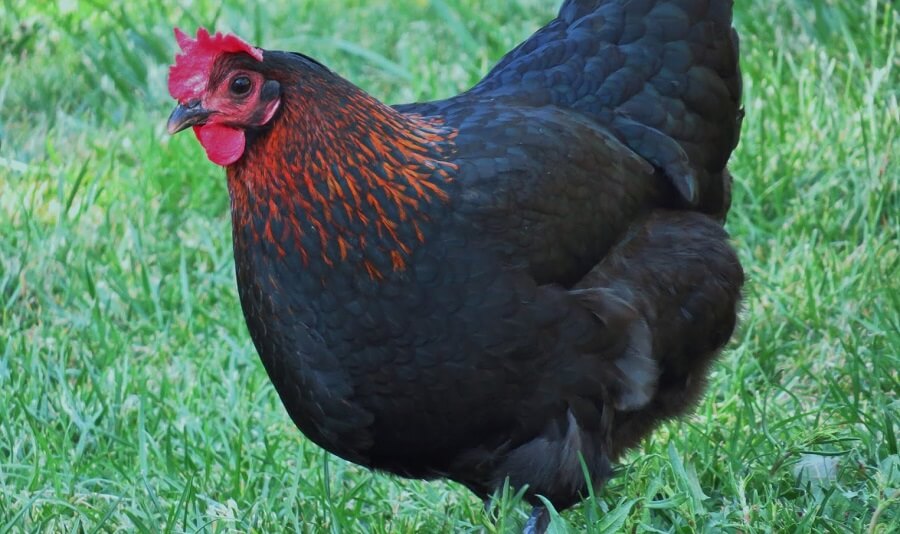
Photo Credit: by ameteurnithologist.blogspot.com
| Climate | Personality | Use | Size | Eggs/ Yr | Brooder | Forages |
| Hot & Cold | Calm, Friendly | Eggs & Meat | M: 8.5 lbs
F: 6 lbs |
250-300 | Yes | Excellent |
- Dual-purpose 300 eggs 8 lbs
- Hybrid: chicks don’t breed true
- Shorter life & laying life
4. Orpington Chickens: One Of The Best All-Around Chicken
The most popular Orpingtons are the Buff Orpington, but the Black Orpington was actually first introduced to the poultry world.
William Cook in Orpington England wanted a better dual-purpose chicken. He wanted a more practical bird than the exotic chickens that had taken the poultry scene by storm.
In 1886 he unveiled his Black Orpington. It was bred from a mix of Minorca, Langshan and Plymouth Rocks.
He wanted it black so that the color would hide the dirt and smoot that was common around England at that time. It had great publicity and became an instant success. Orpington chickens became so popular that they could sell for more than other standard chickens.
A few years later, he used Hamburgs, Dorkings, and Buff Cochins to create the Buff Orpington. The Buff Orpington remains the most popular Orpington today.
Since each color of Orpington comes from different ancestor birds, the Orpington is more of a brand than a specific breed.
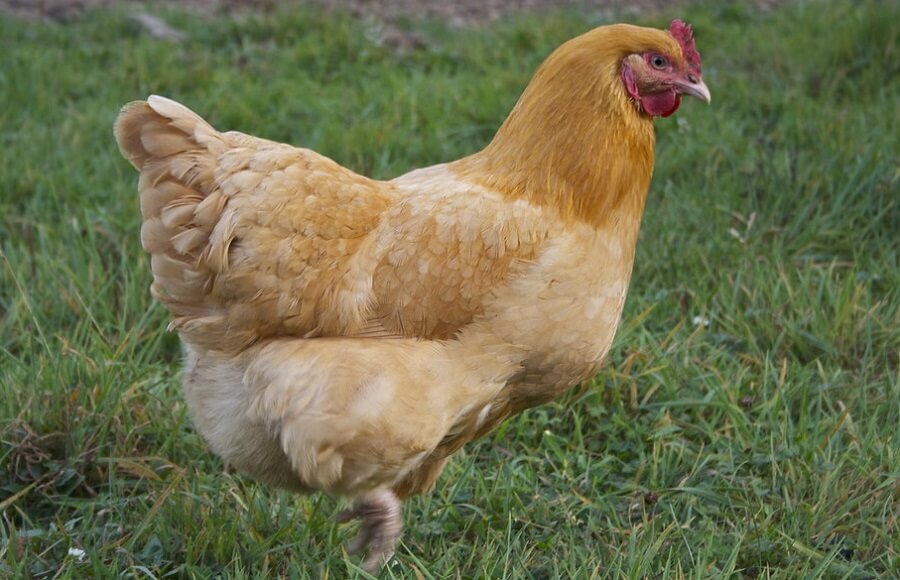
Photo Credit: Elias Gayles Flickr
Identifying An Orpington Chicken
As a result, there are differences between the colors. There are black, buff, white, blue and cuckoo Orpingtons.
Generally, Orpingtons have a low stance and a curvy back. Their feet are pinkish with no feathers. They have a single, red comb with 5 points. There is also a rose comb variety.
Earlobes and wattles are red. The beak is white with a slight pink color. The skin is white and the eyes are reddish bay. Orpingtons have four toes.
Buff Orpingtons were the first breed admitted to the American Poultry Association in 1902. The black and white varieties followed in 1905. Blue was admitted in 1923.
Orpington chickens are considered a heritage breed. Orpingtons live an average of 10-12 years. However, their egg laying drastically reduces with age.
Reasons To Own An Orpington Chicken
Orpington chickens are a heavy bird that was bred for dual purpose. The Buff Orpington remains the most popular of the Orpington birds because of its fine meat quality and high egg-laying abilities. It is truly a dual purpose bird.
The roosters will be about 10 lbs and the hens 8 lbs. For Buff Orpingtons, the roosters are about 8.6 lbs and the hens 7 lbs.
Most Orpingtons lay between 175-200 medium, light brown eggs a year or 3 eggs a week. Buff Orpingtons can lay between 200-280 eggs a year. Orpington hens will get broody.
Once Orpingtons laid as many as 340 eggs a year, but as their coloring and looks were bred, the egg-laying abilities diminished.
Caring For Your Orpington Chicken
Orpington chickens are docile, patient, and friendly. Buff is especially known for being the mildest and calmest of the Orpingtons. They are great with children and won’t get ruffled by being held.
This makes them great pets.
Orpingtons are usually one of the lowest chickens on the pecking order. They don’t pick on other chickens. They are perfect for a beginner flock because of their mellow disposition and calm demeanor.
They are best suited for a small yard. Buff Orpingtons can get lazy in foraging.
They are very cold hardy, but not very heat hardy. They have a thick suit of feathers which keeps them warm, but also means they are subject to mites and fleas.
They were endangered until 2016, but have made a full comeback. They are no longer listed as in danger to any degree.
| Climate | Personality | Use | Size | Eggs/ Yr | Brooder | Forages |
| Cold | Calm Gentle | Eggs & Meat | M: 10 lbs
F: 8.5 lbs |
200 | Yes | Lazy |
- Superb all-purpose bird
- Great beginner chicken
- Mellow, calm personality
5. Wyandotte Chickens: Friendly, Strikingly-Colored Dual Purpose Birds
Wyandottes originated in the North Eastern United States. They were bred by four creators; Fred Houdlette, L Whittaker, John Ray, H. M. Doubleday. They were the first American bred dual-purpose chicken.
Originally they were called Winnebagoes, American Sebrights, Sebright Cochins or Mooney. The name was changed to Wyandottes, after the Wyandotte Indian Nation who helped the first white settlers in Northern New York. Fred’s boat was also named Wyandotte and it was suggested to name the chickens after the boat, which was named after the tribe.
The Sebright bird in England is a separate breed.
They have been rescued from the brink of obscurity and have become a homesteader staple.
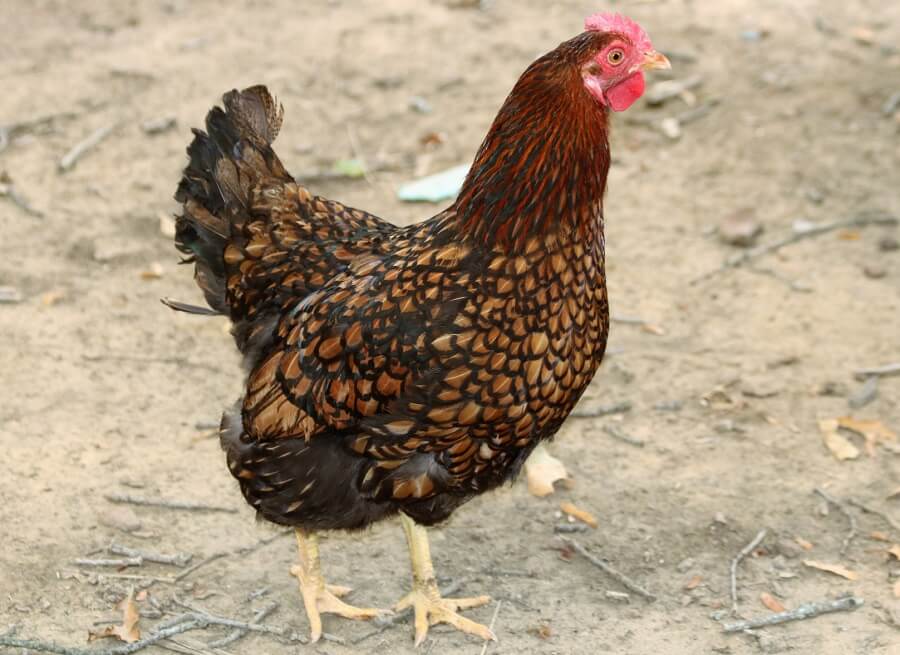
Wyandotte Chicken Features
Wyandotte chickens are deep-breasted birds. They have a stout body and a concave sweep to the tail.
They have red rose combs and stout legs. Their wattles and earlobes are also red. Their feet and shanks are free of feathers. They have four toes.
Wyandotte chickens come in 17 different colors. Official and rare colors include the Silver penciled, golden laced, blue, Columbian and white Wyandottes. Other official colors include black, buff and partridge. Unofficial colors include blue laced, red and barred. They have beautifully laced feathering.
Wyandottes were admitted into the American Poultry Association in 1883. They are considered a heritage chicken. They will usually live between 6-12 years.
Reasons To Own A Wyandotte Chicken
Wyandotte are good-sized birds with dependable egg-laying abilities. They are also valued for their table quality.
Roosters grow to 8-9 lbs (3.6-4 kgs) while hens grow to 6-7 lbs (2.7-.3.1 kgs).
The hens will lay 4-5 large brown eggs a week. That means 180-260 eggs a year. Wyandotte chickens lay light to dark brown eggs. The hens can go broody.
They will also lay throughout the winter, which is a plus for most chicken owners.
Caring For Your Wyandotte Chickens
Wyandottes are not lap chickens, but they are still friendly. In fact, my daughter’s Wyandotte hen is a lap chicken even though they aren’t considered a traditionally lap chicken. They will be at the top of the pecking order in a flock.
They are calm birds, but they are noisy.
That means they aren’t always best for a suburban environment.
They are easy-going and hardy. They will tolerate the cold very well, but need shade in hot weather.
They handle confinement well but do need enough space in a coop. They will live between 6-12 years naturally.
| Climate | Personality | Use | Size | Eggs/ Yr | Brooder | Forages |
| Cold | Calm | Eggs & Meat | M: 9 lbs
F: 7 lbs |
260 eggs | Sometimes | Yes |
- Incredible egg layer
- Friendly, foraging, & content bird
- Great for beginners
6. Dominique Chickens: America’s Oldest Breed Used For Centuries as a Dual Purpose Chicken
Dominiques are America’s oldest chickens. Two stories surround its origins. It was said to have been brought across the ocean by the Pilgrims.
Another story says it came to the U.S. vía the French Colony of Saint Dominique, now Haiti. As a result, the Dominique has had many names throughout the last 200 years.
It has been called Dominicker, Blue Spotted Hen, Old Grey Hen, Pilgrim Fowl, and Dominic.
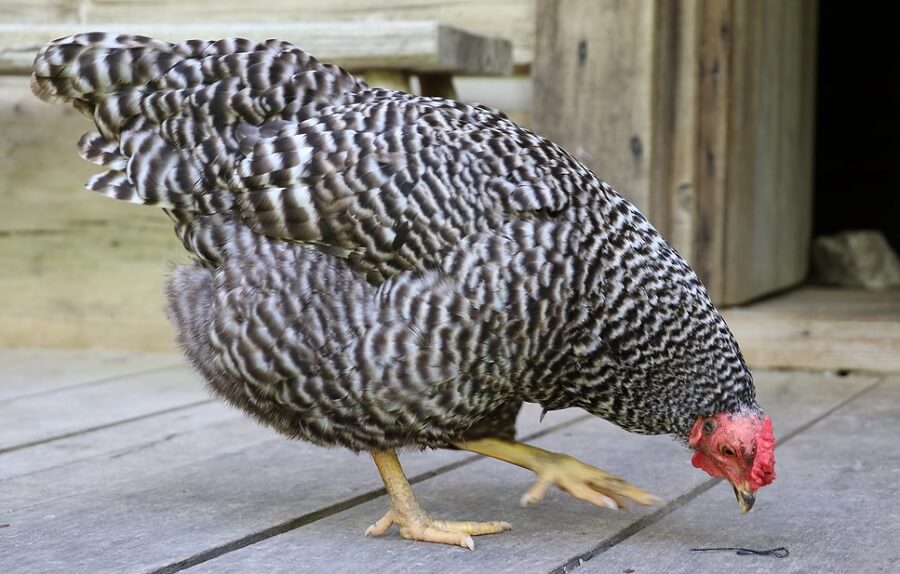
Photo Credit: LicenseAttribution Flickr
Distinguishing A Dominique Chicken
The Dominique looks a lot like the Plymouth Rock. That’s because they were the same breed until 1871. At that point, the New York Poultry Society decided there should be some uniformity in the breed.
That’s when they decided to split the breed. All rose comb chickens became Dominique and all other combs became Plymouth Rock.
The two breed names give a nod to both stories of origin.
The Dominique chicken has a single rose comb. It has a U-shaped, concave back. The tail is held at a 45-degree angle. Heads are held high up.
They have red wattles and comb. Their legs and feet are yellow and they have four toes.
Their barred feathering is staggered and a soft contrast of white and black. They have a mottled appearance.
Dominique chickens were admitted into the American Poultry Association as a separate breed in 1874. They are considered a heritage breed and can live for 8-10 years.
Reasons To Raise Dominique Chickens
The Dominique is a very self-sufficient bird. The early settlers didn’t spare extra grain or feed to raise chickens. The Dominique chickens had to fend for themselves. As a result, they are very good at finding their own food.
They were used for both meat and egg production. Even the feathers were used for mattresses!
The roosters grow to 7 lbs (3.17 kg) and the hens grow to 5 lbs (2.26 kg). They produce nice, tender meat. Hens have a small white spot on their head and males have a larger spot.
Hens lay about 230-270 medium, light brown eggs a year. That’s about 3-4 a week. The hens do occasionally go broody.
They are also very good, attentive mothers and the hatch rate is very high.
Caring For Your Dominique Chicken
They are pretty temperature resistant. They need shade in the heat but are also very resistant to frostbite.
Dominiques are friendly, mellow and chill chickens. They aren’t exactly lap chickens but don’t mind getting carried around. Their sweet temperament makes them great for kids and as pets.
The roosters can get a little aggressive during mating season.
But, other than that, they make a great family rooster and a great backyard rooster. Even a very small backyard could house 2 or 3 Dominiques and keep them happy.
Dominique’s reached a critical endangerment rate after the introduction of commercial breeds. In 1970 only four, known flocks remained. Since then, they have since recovered to a watch status.
However, more recently their numbers have started to decline again. This is because the main promoters of the breed have started getting older and passing away.
They are currently listed in a watch status by the Livestock Conservancy.
| Climate | Personality | Use | Size | Eggs/ Yr | Brooder | Forages |
| Cold | Calm, Friendly | Meat & Eggs | M: 7 lbs
F: 5 lbs |
260 | Sometimes | Yes |
- Kid-friendly rooster
- Self-sufficient
- Great for eggs and meat
7. Austra White Chickens: The Best Free-Range Light Colored Chicken
The Austra White was developed in the early 1900s. They are a cross of a Black Australorp rooster and the White Leghorn hen.
They are more mellow than a leghorn. The roosters are a bit more aggressive than the Australorp.
The key benefits of the Austra White is that it lays similar to a Leghorn, but has the hardiness of an Australorp.

Photo Credit: CackleHatchery.com
Austra White Chicken Uses
Austra Whites are a great dual purpose bird. They usually lay over 240 large, creamy white eggs a year. That’s 4-5 eggs a week!
Hens can start laying as early as 12 weeks old! They lay throughout the year.
But, they are also larger birds. Cocks can average out at 6.5 -7 lbs (3 kgs). Hens will grow to about 5 lbs (2.25 kgs).
Austra Whites have a good feed to egg production ratio. They do well in backyards and smaller spaces.
Austra White Features
Their white color does make them easier for predators to see and more likely to be picked off than darker varieties of chickens so make sure they are well protected.
Pullets will be white with some black specks. They have orange feet and legs with grey coloring down the legs. They have a red comb and wattle.
Austra White chickens are a hybrid chicken. That means that if you breed and male and female Austra White, you won’t end up with Austra White Chicks!
Because they are a hybrid, they aren’t recognized by the American Poultry Association as a breed.
Caring For Your Austra White Chickens
Austra Whites do well in the cold and in warm weather. They are considered a friendly bird. They are good at predator avoidance but will be targeted more by predators. Even so, they are one of the best light-colored birds to stay away from predators. Leghorns are the other.
They do very well free-ranging.
If you don’t plan to free-range your Austra Whites, then make sure that you allow plenty of room for your chickens in the coop. If your ladies start pecking, bullying, or seem stressed out, they probably need more room.
Austra Whites can do well in a backyard or cooped situation if they are allowed enough room to roam. They are friendlier birds so they are usually great for families also.
| Climate | Personality | Use | Size | Eggs/ Yr | Brooder | Forages |
| Cold & Hot | Friendly | Eggs & Meat | M: 6.5 lbs
F: 5 lbs |
250+ | Average | Yes |
- Good backyard chickens
- Dual purpose 240 + eggs
- Cold & Heat tolerant
Continue Reading in Part 2 of the Best Dual Chicken Breeds For Eggs And Meat.
Feature Image Credit: casey crowing on the fence
My Favorite Chicken and Duck Supplies
This list contains affiliate products. Affiliate products do not cost more but helps to support BestFarmAnimals and our goal to provide farm animal owners with accurate and helpful information.
Manna Pro Oyster Shell keeps eggs strong. Before I gave my chickens oyster shell, I had the oddest eggs, many with weak and irregular shells. Now, I don’t have an issue.
Layer Feed by Manna Pro. I like pellets rather than crumbles as my chickens eat them better and less gets wasted or scavenged by rodents. A good layer feed makes the difference in hens laying many more eggs.
My chickens love this mealworm treat, which gives added protein, something that’s great during molting and winter months.
There are many ways to feed and water your chickens. I like this food and water setup the best because it reduces waste, saves me time feeding and watering, and keeps the food fresh longer. Except, in the winter, I use a heated waterer. The only problem is the heated waterers need to be replaced every few years.
I love this chicken veggie hanger. It makes it easy to give your chickens produce from the garden and keep them occupied in the winter with a fresh head of lettuce.
These chicken toys are a hoot! They will help curb bullying and keep your chickens active, especially in the winter when hens tend to get more lethargic.

